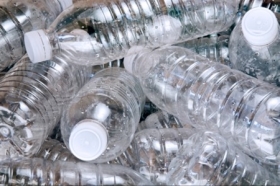Plant Plastic: Future of Plastic Is in Plants, not Petroleum

We use a staggering 2 million plastic bottles every five minutes in the United States, the large majority of which are PET plastic. And our rate of recycling is worse than dismal: not quite 13 percent nationwide.
Glimmers of hope are emerging. In states with mandatory recycling laws, the recycling rates are almost 28 percent for PET plastic. Only 10 states have the so-called "bottle bills," yet those states have the highest rate of recycling in the country. Of these, two made major headway in 2010:
- California reached 82 percent recycling; and
- Washington state achieved an overall recycling rate of 49 percent.
It begs the question: What would happen if the rest of the country implemented similar laws?
Plastic is a large expense in the beverage industry. The global price of oil directly affects the type of plastic being produced. In 2008, when the price of oil soared to more than $100 per barrel, companies began scrambling to find alternatives to plastic bottles.
Enter bioplastics. Several companies have created bottles made from plant-based materials. Coca-Cola Company launched its Dasani PlantBottle, made with up to 30 percent plant-based material, and its Odwalla brand PlantBottle, made with 100 percent PLA (polylactide or polylactic acid), a polymer made from renewable plant materials.
Another beverage company to make the switch is Nature’s Bottles. Its PLA bottles are made from Ingeo, a purportedly non-GMO, corn-based material that is touted as the world’s first biopolymer to show a significant reduction in greenhouse gas emissions.
PLA is fairly unique, says Mike Centers, executive director of BioCor, a northern California-based recycler of PLA. You can recycle it relatively inexpensively compared to PET and other plastics, he says. And it can be made into useful products such as clamshells (traditional throwaways) and even beer cups. All the beer cups at the Oakland Coliseum stadium are made from PLA.
Centers launched BioCor in 2010 to help create a market and an infrastructure for collecting plant-based waste material, both industrial and post consumer. Watch this video on end-of-life PLA:
According to research firm Pira International, nearly half of all bioplastic packaging in the world is PLA.
The market for the material is thriving, says Centers. Bioplastics is a high-growth industry. In fact, manufacturers want to use PLA to develop secondary markets, Centers adds.
Coca-Cola took “an innovative approach” with the Dasani PlantBottle, says Centers. It took one of the chemicals that make up PET and found a way to derive it from plants instead.
“They’ve captured the imagination of what everyone’s trying to do but haven’t gotten there yet,” Centers says.
HDPE (high density polyethylene) is a petroleum-based plastic, one of the most common types of plastic products found today. Both HDPE and PET types of plastics are moving towards being plant based, says Centers.
But it all depends on the price of oil. If oil is high, Centers says, more manufacturers will convert to PLA as a packaging source.
One company that recently announced it is jumping onto this bandwagon is PepsiCo. Earlier this year, the giant beverage manufacturer revealed its plans to market a 100 percent plant-based PET bottle. It had examined the possibility of using PLA but found that it did not meet the company’s needs.
There is definitely a bright future for PLA. It can be recycled as easily as PET plastic, and it takes only 27 to 50 days for it to break down in industrial composting facilities.
Companies interested in utilizing plant-based plastic can reach out to companies such as Nature Works (an independent company that owns the patent for Nature’s Bottles and invested in by Cargill and PTT Chemical) or a converter such as Jamplast or Mirel that can make products out of PLA. Or learn more about BioCor and its progress at BioCor.org.
Check out more articles by Debra Atlas.
© 2011 SCGH, LLC.
Image credit: http://www.plastech.biz/news/article_3725_1/Dow-to-test-plastic-waste-as-fuel-source
Article originally published: http://www.sierraclubgreenhome.com/go-green/recycling/future-of-plastics-is-in-plants-not-petroleum/